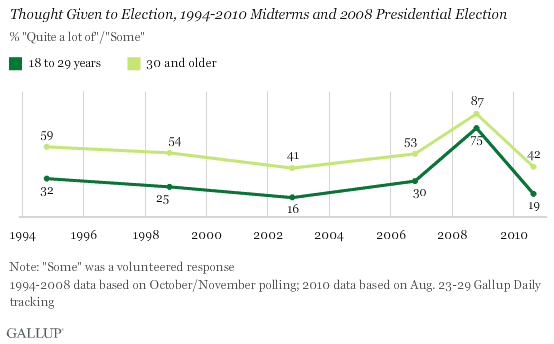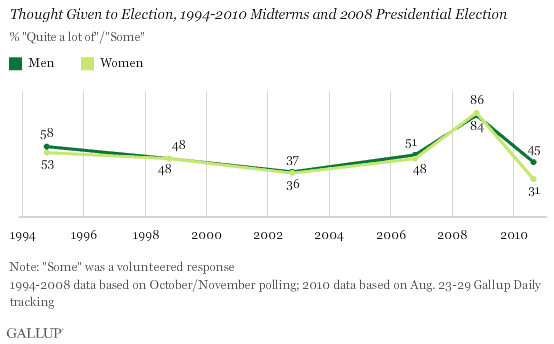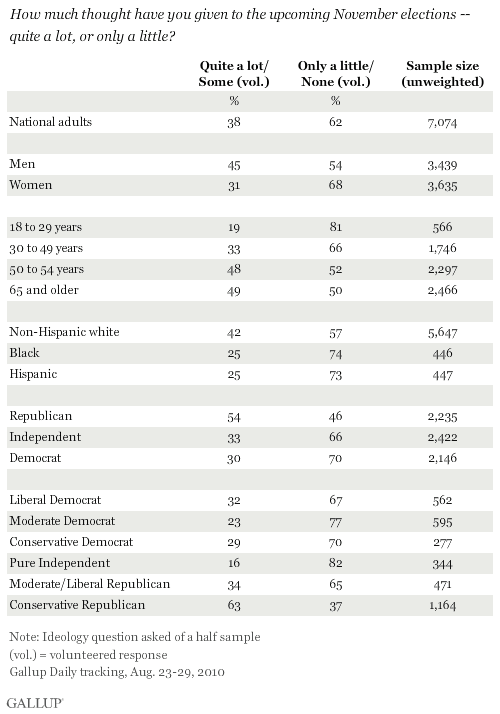PRINCETON, NJ -- Minority and young voters made a significant mark on the 2008 presidential election with their high turnout; today, however, these groups appear to have reverted to previous levels of interest in voting in the context of midterm elections. Most notably, in contrast to 2008, when whites and blacks were about equally likely to say they were giving "quite a lot of" or "some" thought to the presidential election, whites are much more likely than blacks to be thinking about the 2010 elections: 42% vs. 25%, a gap exceeding those from recent midterm elections.

Gallup's "thought given to the election" question is a key determinant of "likely voters" in Gallup's multipart likely voter model. The full model will be implemented closer to Election Day; however, the "thought" question was asked as part of Gallup Daily tracking from Aug. 23-29, to get an early gauge on potential turnout among subgroups. (See full results for this question on page 2 of this report.)
Although public attention to elections is much higher in presidential than in midterm years, a comparison of the relative "thought" levels among various subgroups in 2008 versus today may be useful in determining whether the Democrats are on track to mobilize key elements of the coalition that helped them win the White House two years ago. These data suggest they are not.
Young Adults' Attention Is Low, Similar to Past Midterms
The gap between young adults (aged 18 to 29) and older adults (aged 30+) in their election attention levels was relatively narrow in 2008 -- 12 percentage points -- but the 23-point difference today (42% vs. 19%) is similar to the average 26-point gap seen in October-November of prior midterms, from 1994 through 2006. Again, this suggests that the relatively higher turnout of young voters in 2008 may not be repeated in 2010.

Men and women have had similar turnout rates in recent elections, including in 2008 -- and this is reflected in the similar percentages giving quite a lot of or some thought to the elections each year. At this point in 2010, however, women are much less likely than men to be giving this level of thought to this year's midterms, 31% vs. 45%.

Bottom Line
Earlier this year, President Obama identified women, blacks, and young voters among the groups he highlighted as critical to a voter mobilization effort designed to help the Democrats hold their congressional majority. These groups made up a good portion of the "new voters" who propelled Obama to victory in 2008. However, Gallup data suggest they are not poised to provide the same kind of boost for Democratic candidates this fall. As a result, and because of the extraordinarily keen interest in the elections that conservative Republicans currently display, Republicans overall currently enjoy a 54% to 30% lead over Democrats in "thought given to the election."
If these numbers hold, the preservation of the Democratic majority in Congress would depend on the Democrats' increasing their appeal to voters at large -- recent Gallup polling shows the Democrats trailing the Republicans among registered voters -- rather than counting on heightened turnout from their strongest backers.
The latest results are based on telephone interviews conducted as part of Gallup Daily tracking Aug. 23-29, 2010, with a random sample of 7,075 adults, aged 18 and older, living in all 50 U.S. states and the District of Columbia, selected using random-digit-dial sampling.
For results based on the total sample of national adults one can say with 95% confidence that the maximum margin of sampling error is ±1 percentage point.
Interviews are conducted with respondents on landline telephones and cellular phones, with interviews conducted in Spanish for respondents who are primarily Spanish-speaking. Each daily sample includes a minimum quota of 150 cell phone respondents and 850 landline respondents, with additional minimum quotas among landline respondents for gender within region. Landline respondents are chosen at random within each household on the basis of which member had the most recent birthday.
Samples are weighted by gender, age, race, Hispanic ethnicity, education, region, adults in the household, cell phone-only status, cell phone-mostly status, and phone lines. Demographic weighting targets are based on the March 2009 Current Population Survey figures for the aged 18 and older non-institutionalized population living in U.S. telephone households. All reported margins of sampling error include the computed design effects for weighting and sample design.
In addition to sampling error, question wording and practical difficulties in conducting surveys can introduce error or bias into the findings of public opinion polls.
For more details on Gallup's polling methodology, visit www.gallup.com.

